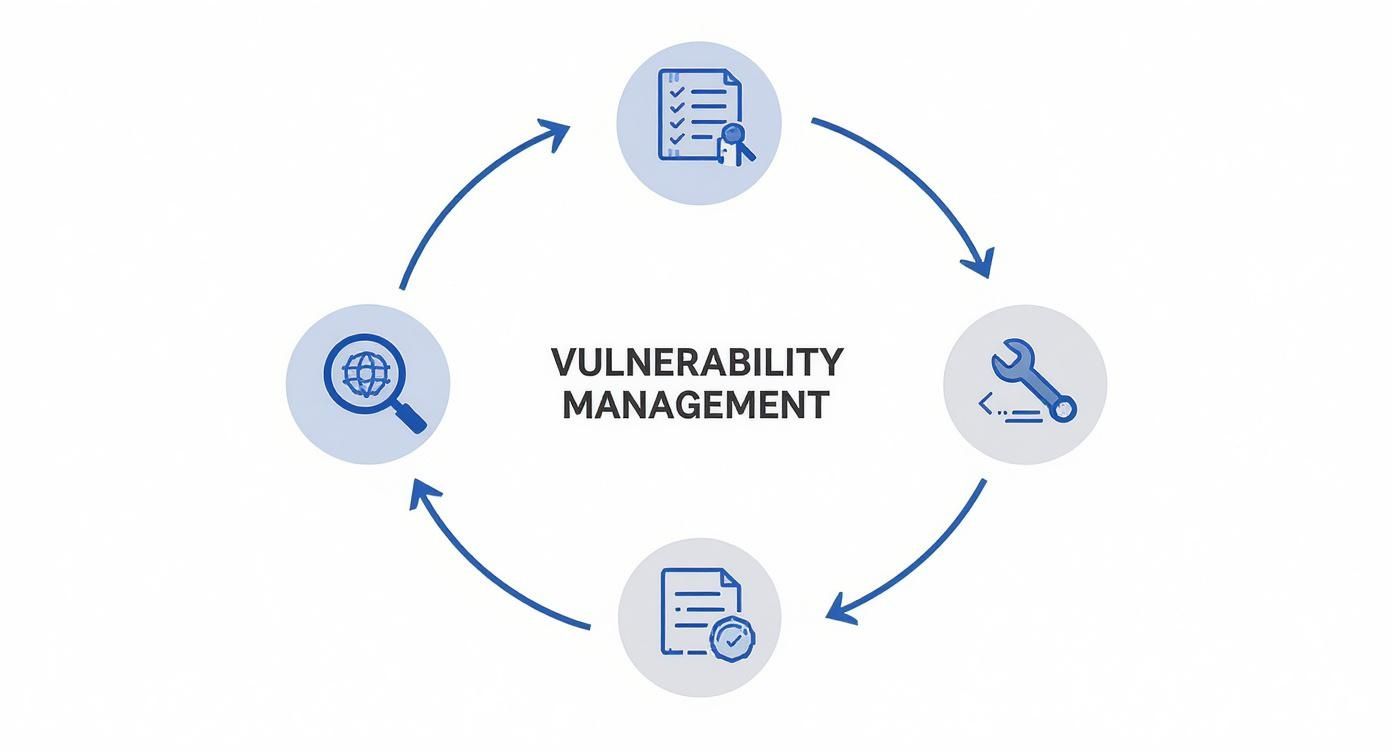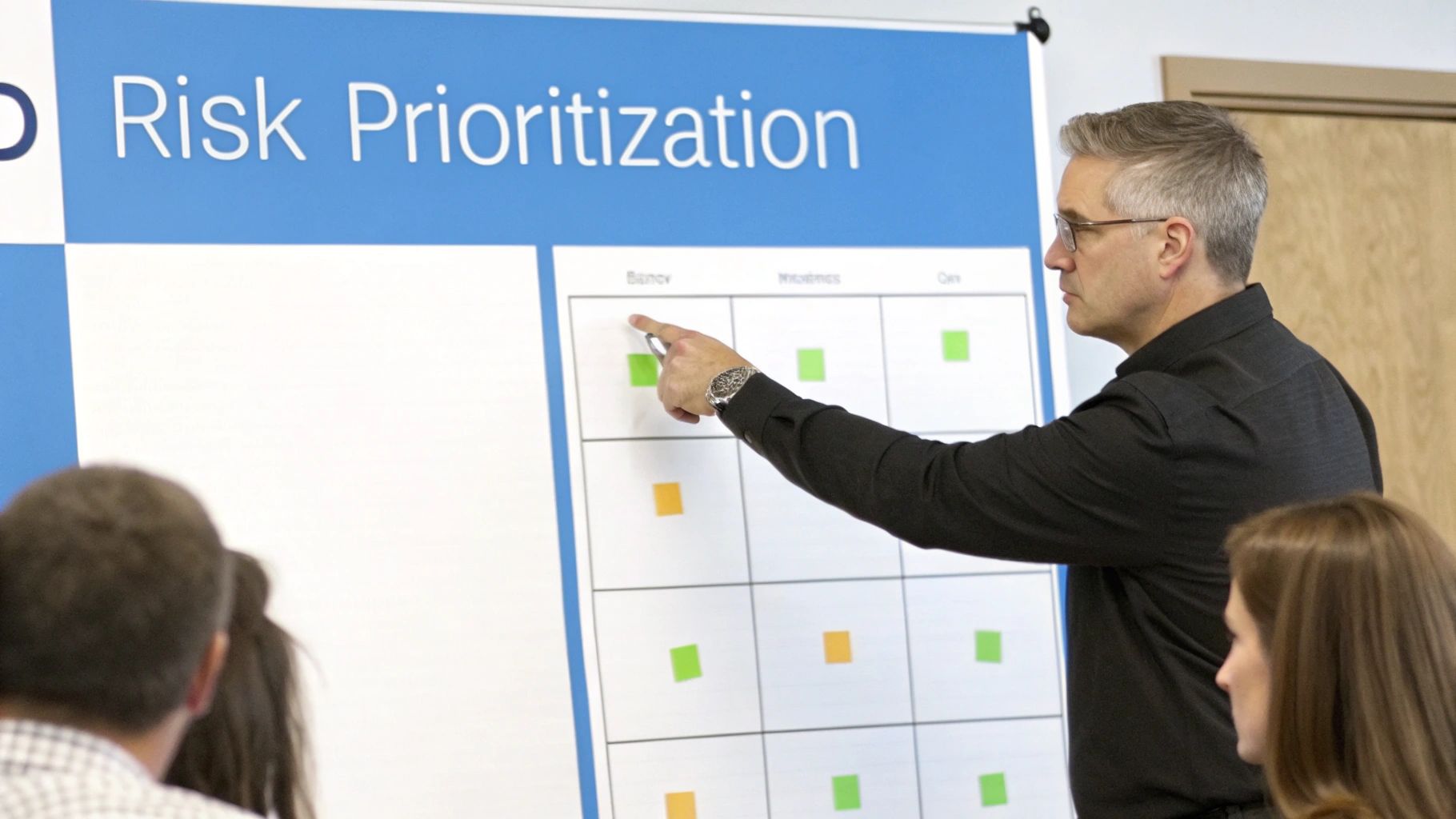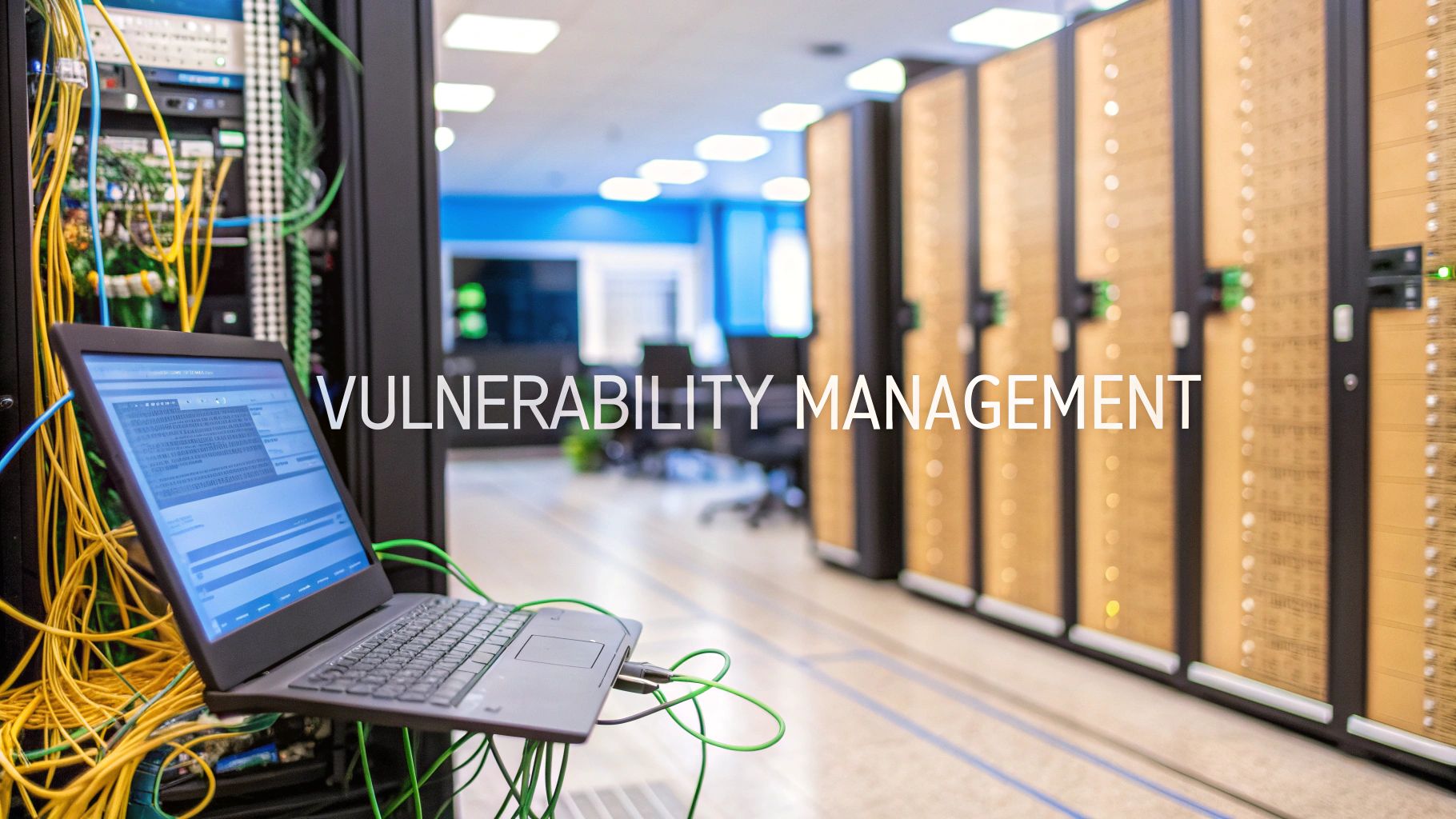For any MSP or vCISO, a solid vulnerability management program plan is your strategic roadmap. It's how you navigate the constant storm of cyber threats and nail tough compliance standards like SOC 2, HIPAA, and PCI DSS. This isn't just about running a scan now and then. We're talking about a continuous cycle of discovering assets, assessing real-world risk, reporting on what matters, and fixing security holes before they get exploited. A well-defined plan shifts your team from constantly putting out fires to proactively managing risk for your clients.
Create Your Vulnerability Management Framework
For any MSP, vCISO, or GRC company, creating a vulnerability management framework is step one. Think of it as the blueprint for your entire security operation. It lays out the rules, who does what, and the processes that guide how you shield clients from threats. Without this structure, your efforts will feel chaotic, leaving dangerous gaps in your clients' security. This framework is your commitment to a structured, repeatable security process. It's what you show auditors for standards like ISO 27001 or PCI DSS to prove you have a mature program, giving your clients peace of mind.
Define Scope and Objectives for Your Plan
Before you can protect anything, you need to know exactly what you're protecting and why. Are you focused on a client’s cloud infrastructure for their upcoming SOC 2 audit? Or are you building a baseline security service for all your small business clients to keep them HIPAA compliant? Getting this clear from the start prevents wasted effort. Your objectives should be specific and measurable, like cutting critical vulnerabilities by 50% next quarter or getting patch times under 30 days for high-severity findings.
Establish Clear Roles and Responsibilities
A plan is useless if no one knows who’s supposed to do what. A strong vulnerability management program plan clearly outlines roles and responsibilities for everyone involved. This kills confusion and ensures accountability when a critical issue surfaces. For example, who runs the scans? Who triages the results to decide what’s a real risk versus just noise? Most importantly, who is on the hook for deploying the patch? For an MSP, this often means coordinating between your own security team and the client’s internal IT staff.
Integrate Your Tools and Processes Together
Your framework also needs to nail down the specific tools and processes you'll use. This includes your vulnerability scanner, your ticketing system for tracking remediation, and your reporting dashboard. The real magic happens when you make these systems talk to each other. An automated workflow that takes a high-priority finding and instantly creates a ticket for the right technician is far more efficient than doing it all by hand. This is also where you define your risk assessment methodology, ensuring everyone on your team prioritizes vulnerabilities the same way. For a deeper dive, you can explore the relationship between threat and vulnerability management in our detailed guide.
Discover and Catalog All Client Assets
You can't protect what you don't know exists. This is the golden rule of cybersecurity and the first real step in your vulnerability management program plan. It means creating a complete inventory of everything in your clients' environments, including servers, laptops, firewalls, cloud instances, and applications. For an MSP juggling multiple client setups, this is ground zero. Without a detailed asset list, you're trying to guard a house without knowing where all the doors and windows are.

Classify Assets Based On Business Importance
Once you know what’s out there, you need to figure out what actually matters. Not all assets are created equal. A database server holding financial data for a client needing PCI DSS compliance is far more critical than a public-facing marketing website. As a vCISO or GRC consultant, you’ll work with the client to assign a "criticality" rating to each asset based on the data it handles, its role in the business, and any compliance mandates it falls under like HIPAA or SOC 2. This step is crucial because it directly feeds into your risk assessment and prioritization down the line. To make sure your asset inventory is always current, you need to implement strong continuous monitoring strategies.
Prioritize Risks Beyond Simple CVSS Scores

As an MSP, you're staring down a constant flood of new vulnerabilities. Trying to patch everything is a losing game. A solid vulnerability management program plan doesn’t just find flaws—it tells you which ones to fix first. Smart prioritization is your best weapon for cutting through the noise and focusing on what actually puts your clients at risk. The Common Vulnerability Scoring System (CVSS) is a decent starting point, but relying only on that score is like driving without a map.
Layer Business Context On Top of Scores
A "critical" 9.8 CVSS vulnerability on an isolated test server is just background noise. But a "medium" 6.5 flaw on a client's server holding patient data? That’s a five-alarm fire. The context of the asset and its data is everything, especially when compliance frameworks like HIPAA or PCI DSS are involved. This is where an MSP or vCISO proves their worth, shifting clients from a reactive, score-chasing frenzy to a proactive, risk-based strategy.
Execute and Validate Your Remediation Efforts

Discovering vulnerabilities is just the first part of the game. A solid vulnerability management program plan is measured by how well you actually fix what you find. For any MSP or GRC company, this is where you deliver on your security promises. It starts with a clear, actionable patching plan for your technical teams, with deadlines based on the risks you’ve already prioritized. This means setting up Service Level Agreements (SLAs) for patching that everyone understands.
Validate That the Fix Actually Worked
So, you’ve deployed the patch and closed the ticket. The single most overlooked step in remediation is validation. You have to prove the fix eliminated the risk. Just trusting a patch worked is a massive gamble, especially when compliance audits for frameworks like ISO 27001 or SOC 2 are on the line. First, run an automated rescan of the patched asset for a quick thumbs-up. The only way to be absolutely certain a vulnerability is gone is to have a human expert try to exploit it again. This is where manual pentesting becomes an indispensable part of your program.
Integrate Affordable Manual Pentesting Into Your Plan
If you're an MSP or a vCISO, you know that automated scans are only half the battle. Your vulnerability management program plan isn't truly complete until you prove it works against a real-world attacker. That’s what a penetration test is for. The problem is, the traditional pentesting industry is often a nightmare for partners, with sky-high prices, long wait times, and vague reports. It makes integrating regular testing feel almost impossible.
A Channel-Only Solution for MSP Resellers
We built our service to fix this broken model. As a strictly channel-only partner, we will never compete with you for your clients. Our whole business is designed to make our reseller partners look like security rockstars. We deliver fast, affordable, and thorough manual pentesting that you can sell as your own. Our certified professionals—holding top-tier certs like OSCP, CEH, and CREST—get to work fast. They don't just run a scanner; they manually hunt for and try to exploit the very vulnerabilities your program is supposed to fix.
White Label Pentesting That Fits Your Program
Once the test is done, we hand over a comprehensive, actionable report. The best part? It’s completely white label. You can add your own branding and present it directly to your client. The report clearly explains what we found, the real-world risk it poses, and how to fix it, which reinforces your role as their trusted security advisor. This approach lets you fold expert validation right into your vulnerability management program without the massive overhead of an in-house team. You get the proof you need for compliance audits, your clients get peace of mind, and you make your security offerings that much stronger.
Report on Progress and Program Improvement
A vulnerability management program plan isn't a "set it and forget it" checklist. Without solid reporting, all the hard work of scanning, prioritizing, and patching is basically invisible. You have to translate those technical wins into real business value that everyone, from the CEO to the sysadmin, can understand. Good reporting is how you prove the program's value, get teams to act, and show clients you’re leveling up their security. The report you give a client's executive team should look nothing like the one you give to technicians.
Use Reporting Metrics to Refine Your Process
Great reports do more than just show what you've done; they shine a light on where your program can get better. By tracking the right Key Performance Indicators (KPIs), you can spot bottlenecks and make smart, data-driven tweaks to your vulnerability management program plan. Are your teams constantly missing patching SLAs for critical vulnerabilities? Maybe your risk assessment criteria need an adjustment. Tracking metrics like Mean Time to Remediate (MTTR) and scan coverage helps you move from just putting out fires to actually improving the entire process. This is what solidifies your role as a trusted security partner for any MSP or vCISO.
Frequently Asked Vulnerability Management Questions
When you're building out a vulnerability management program plan, a few key questions always pop up. For any MSP or vCISO, getting the answers right is the difference between a program that just checks a box and one that actually protects your clients and satisfies compliance auditors.
How Often Should We Scan Client Networks?
It all comes down to the client's risk appetite and what compliance frameworks they live under. For critical systems—like those handling credit card data under PCI DSS you should be running authenticated scans weekly, if not daily. You can't afford to let a new vulnerability sit on a critical asset. For lower-risk infrastructure, a monthly scan is probably fine. The most important part isn't the exact timing but the consistency.
What's the Difference Between Vulnerability Management and Pentesting?
Vulnerability management is your routine security check-up. It's an ongoing, mostly automated process of finding, prioritizing, and fixing known weaknesses across the entire network. A penetration test, on the other hand, is a targeted, manual pentesting assault simulation. A real person, an ethical hacker, is actively trying to pick the locks and find a way inside to see what damage they could do. Pentesting is how you prove your vulnerability management program is actually working.
What If a Vulnerability Can't Be Patched Immediately?
It happens more than you'd think. Maybe a patch isn't available yet, or applying it would break a critical app. Your program must have a formal process for these exceptions. When you can't patch, you pivot to compensating controls, like isolating the vulnerable system on its own network segment or using a web application firewall (WAF). The key is to document everything with a business justification and a target date for a permanent fix. This is what auditors for frameworks like SOC 2 or HIPAA demand to see.
At MSP Pentesting, we're built to help our channel partners deliver that critical security validation without the enterprise price tag. Our certified pentesters give you the manual, white-labeled reports you need to prove your vulnerability management program is rock-solid.


.avif)
.png)